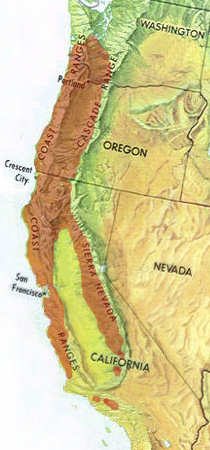Wild PCN iris:
Where did they come from?
Almost all of the nearly 300 recognized wild iris species live in Asia and Europe. Only a couple dozen, all members of a single group - the "beardless iris" - somehow reached North America.
The rich spring and summer flora of Washington, Oregon and California includes an attractive array of wild irises. Where could they have come from? How did they get there?

Ancestors of today's Pacific Coast irises, like those of the other American iris groups, evidently crossed into the New World at various times during the Ice Ages. On repeated occasions, the shallow seas between the two continents receded enough to be replaced by a broad region of dry land. Under favorable conditions, the iris expanded their new ranges eastward to the Atlantic shores and south at least into northern Mexico. Today there are many plants shared, like Iris setosa, on both sides of the Berring Sea.
Glaciers periodically blanketed much of the northern hemisphere, making huge areas uninhabitable. Remnant iris populations must have lived in isolated favorable places for thousands of years - surviving by adapting to the local conditions.

During the warmer interglacials, some of the plants once again came into contact. But by then, they had changed, and many retained their new distinctive appearance and choice of habitat. This experience was repeated over and over again during successive Glacial / Interglacial cycles.
The time in isolation must have been long enough for irises from different areas to look and act differently, but not to become mutually infertile. When the ice retreated and their ranges once again overlapped, many were still able to cross and form hybrids. This seems to be the condition for all the PCI species; they can even sometimes cross with some of the Siberian irises (although "Calsibe" hybrids are almost always infertile).
Botanists classify the North American beardless irises into several "series". Those growing along the Pacific Coast are members of the Californicae series. Their closest relatives appear to be among the Siberian irises (Sibericae series) that live between Japan, China, and the Himalayas. The Californicae iris and most of the Siberian species have the same chromosome number: N = 20.
THE OTHER NEW WORLD NATIVE IRIS
With three exceptions, the only wild irises in the lower western United States are all members of the Californicae series. The other seven beardless iris groups growing wild in North America are:
- Evansia series: Iris tenuis (western Oregon), Iris cristata (southeastern & central U.S.), and Iris lacustris (Great Lakes region).
- Longipetalae series: Iris missouriensis (Rocky & Sierra Nevada mountains), Iris longipetala (lowland western California).
- Hexagonae series: (all in the lower & middle Mississippi Basin) - Iris fulva, Iris brevicaulis, Iris giganticaerulea, Iris hexagonae, and Iris nelsonii.
- Laevigatae series: Iris versicolor (New Brunswick to Georgia), and Iris virginica (Indiana to Louisiana).
- Prismaticae series: Iris prismatica (Maine to the Carolinas).
- Tripetalae series: Iris setosa (northern Asia, Alaska, eastern Canada & Maine), Iris tridentata (Florida, Tennessee, the Carolinas).
- Vernae series: Iris vernae (Kentucky & Georgia).